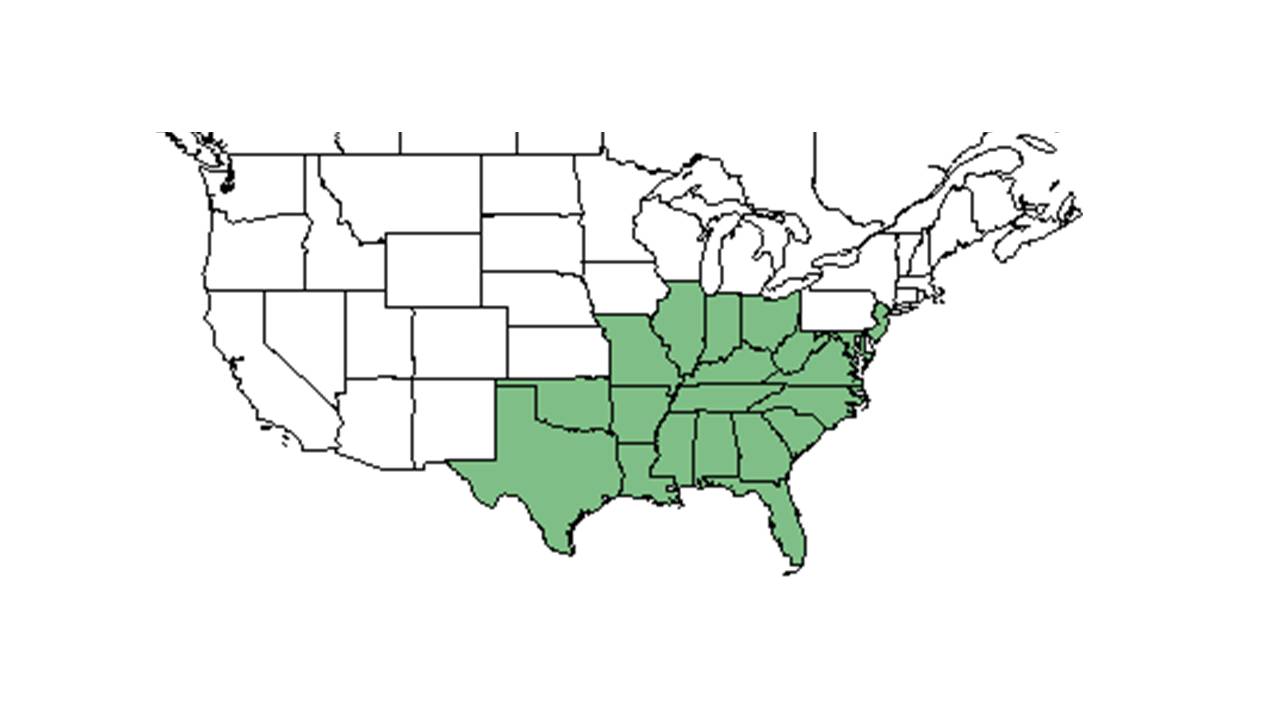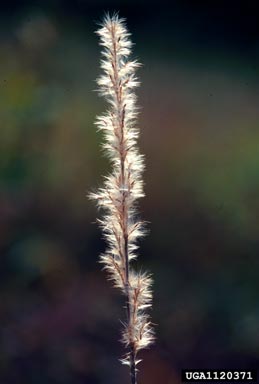Difference between revisions of "Erianthus alopecuroides"
Adam.Vansant (talk | contribs) |
|||
| (One intermediate revision by one other user not shown) | |||
| Line 35: | Line 35: | ||
==Ecology== | ==Ecology== | ||
===Habitat=== <!--Natural communities, human disturbed habitats, topography, hydrology, soils, light, fire regime requirements for removal of competition, etc.--> | ===Habitat=== <!--Natural communities, human disturbed habitats, topography, hydrology, soils, light, fire regime requirements for removal of competition, etc.--> | ||
| − | This species grows in roadsides, fields, and woodland borders.<ref name= "Weakley"/> In the Coastal Plain in Florida and Georgia, ''E. alopecuroides'' can be found in longleaf pine forests, annually burned pinelands, fallow quail food patches, frequently burned mature longleaf pine-wiregrass communities, bordering wild plum thickets, pine-oak-hickory woods, mixed hardwood forests, and mesic woodlands. It can also be found along roadsides, cutover pineland clayhills, and powerline corridors. Soils include sandy loam, clayey soil, and loamy sand.<ref name=fsu>Florida State University Robert K. Godfrey Herbarium database. URL: http://herbarium.bio.fsu.edu. Last accessed: July 2015. Collectors: R. A. Norris, D. E. Powell, Robert K. Godfrey, Roy Komarek, Loran C. Anderson, Richard S. Mitchell, Andre F. Clewell, Travis MacClendon, B. Boothe, M. Boothe, K. MacClendon, Cindi Stewart, Annie Schmidt. States and Counties: Florida: Calhoun, Gadsden, Jackson, Jefferson, Leon, Liberty, Okaloosa, Wakulla. Georgia: Thomas. Compiled by Tall Timbers Research Station and Land Conservancy.</ref> It is considered to be a characteristic species of the shortleaf pine-oak-hickory community in the Red Hills region of northern Florida and southern Georgia.<ref>Clewell, A. F. (2013). "Prior prevalence of shortleaf pine-oak-hickory woodlands in the Tallahassee red hills." Castanea 78(4): 266-276.</ref> Also in the Red Hills region, this species was found as a dominant plant species of old field sites rather than native groundcover sites.<ref>Ostertag, T. E. and K. M. Robertson (2007). A comparison of native versus old-field vegetation in upland pinelands managed with frequent fire, south Georgia, USA. Proceedings of the 23rd Tall Timbers Fire Ecology Conference: Fire in Grassland and Shrubland Ecosystems, Tallahassee, Tall Timbers Research Station.</ref> | + | This species grows in roadsides, fields, and woodland borders.<ref name= "Weakley"/> In the Coastal Plain in Florida and Georgia, ''E. alopecuroides'' can be found in longleaf pine forests, annually burned pinelands, fallow quail food patches, frequently burned mature longleaf pine-wiregrass communities, bordering wild plum thickets, pine-oak-hickory woods, mixed hardwood forests, and mesic woodlands. It can also be found along roadsides, cutover pineland clayhills, and powerline corridors. Soils include sandy loam, clayey soil, and loamy sand.<ref name=fsu>Florida State University Robert K. Godfrey Herbarium database. URL: http://herbarium.bio.fsu.edu. Last accessed: July 2015. Collectors: R. A. Norris, D. E. Powell, Robert K. Godfrey, Roy Komarek, Loran C. Anderson, Richard S. Mitchell, Andre F. Clewell, Travis MacClendon, B. Boothe, M. Boothe, K. MacClendon, Cindi Stewart, Annie Schmidt. States and Counties: Florida: Calhoun, Gadsden, Jackson, Jefferson, Leon, Liberty, Okaloosa, Wakulla. Georgia: Thomas. Compiled by Tall Timbers Research Station and Land Conservancy.</ref> It is considered to be a characteristic species of the shortleaf pine-oak-hickory community in the Red Hills region of northern Florida and southern Georgia.<ref>Clewell, A. F. (2013). "Prior prevalence of shortleaf pine-oak-hickory woodlands in the Tallahassee red hills." Castanea 78(4): 266-276.</ref> Also in the Red Hills region, this species was found as a dominant plant species of old field sites rather than native groundcover sites.<ref>Ostertag, T. E. and K. M. Robertson (2007). A comparison of native versus old-field vegetation in upland pinelands managed with frequent fire, south Georgia, USA. Proceedings of the 23rd Tall Timbers Fire Ecology Conference: Fire in Grassland and Shrubland Ecosystems, Tallahassee, Tall Timbers Research Station.</ref> ''E. alopecuroides'' was found to be neutral in its short-term response to single mechanical soil disturbances, but a decreaser in its long-term response following cessation of repeated soil disturbance.<ref name=Dixon>Dixon, C. M., K. M. Robertson, A. M. Reid and M. T. Rother. 2024. Mechanical soil disturbance in a pine savanna has multiyear effects on plant species composition. Ecosphere 15(2):e4759.</ref> |
Associated species include ''Andropogon'' sp., ''Pinus palustris'', ''Aristida'' sp., ''Quercus'' sp., and others.<ref name= "fsu"/> | Associated species include ''Andropogon'' sp., ''Pinus palustris'', ''Aristida'' sp., ''Quercus'' sp., and others.<ref name= "fsu"/> | ||
| Line 46: | Line 46: | ||
===Fire ecology=== <!--Fire tolerance, fire dependence, adaptive fire responses--> | ===Fire ecology=== <!--Fire tolerance, fire dependence, adaptive fire responses--> | ||
''E. alopecuroides'' has been observed to grow in annually burned pinelands<ref name= "fsu"/> such as those on the Pebble Hill plantation in north Florida where populations have been known to persist through repeated annual burns.<ref>Robertson, K.M. Unpublished data collected from Pebble Hill Fire Plots, Pebble Hill Plantation, Thomasville, Georgia.</ref> | ''E. alopecuroides'' has been observed to grow in annually burned pinelands<ref name= "fsu"/> such as those on the Pebble Hill plantation in north Florida where populations have been known to persist through repeated annual burns.<ref>Robertson, K.M. Unpublished data collected from Pebble Hill Fire Plots, Pebble Hill Plantation, Thomasville, Georgia.</ref> | ||
| + | |||
<!--===Pollination===--> | <!--===Pollination===--> | ||
| − | === | + | ===Herbivory and toxicology===<!--Herbivory, granivory, insect hosting, etc.--> |
''E. alopecuroides'' consists of approximately 2-5% of the diet for various terrestrial birds.<ref>Miller, J.H., and K.V. Miller. 1999. Forest plants of the southeast and their wildlife uses. Southern Weed Science Society.</ref> | ''E. alopecuroides'' consists of approximately 2-5% of the diet for various terrestrial birds.<ref>Miller, J.H., and K.V. Miller. 1999. Forest plants of the southeast and their wildlife uses. Southern Weed Science Society.</ref> | ||
| + | |||
<!--===Diseases and parasites===--> | <!--===Diseases and parasites===--> | ||
Latest revision as of 20:19, 1 August 2024
| Erianthus alopecuroides | |
|---|---|

| |
| Saccharum alopecuroidum (synonym shown); Photo by James H. Miller & Ted Bodner, Southern Weed Science Society, Bugwood.org | |
| Scientific classification | |
| Kingdom: | Plantae |
| Division: | Magnoliophyta – Flowering plants |
| Class: | Liliopsida – Monocotyledons |
| Order: | Cyperales |
| Family: | Poaceae ⁄ Gramineae |
| Genus: | Erianthus |
| Species: | E. alopecuroides |
| Binomial name | |
| Erianthus alopecuroides (L.) Nutt. | |

| |
| Natural range of Erianthus alopecuroides from USDA NRCS Plants Database. | |
Common name: Silver plumegrass
Contents
Taxonomic notes
Synonyms: Saccharum alopecuroides (Linnaeus) Nuttall; Saccharum alopecuroideum (Linnaeus) Nuttall; Saccharum alopecuroidum; Erianthus divaricatus (Linnaeus) A.S. Hitchcock.[1]
Varieties: none.[1]
Description
Erianthus are "coarse perennials from hardened bases or short rhizomes; culms usually purplish, nodes usually, glabrous or upper appressed pubescent, internodes usually glabrous. Leaves primarily cauline; blades scaberulous, usually densely long hirsute above ligule; sheaths usually glabrous; ligules membranous, ciliate, 1-4 mm long; collars long-hirsute. Panicle solitary, terminal, ovoid to ellipsoid. Racemes numerous, most ascending, joints and pedicels subequal, 2-6 mm long, scaberulous or villous. Spikelets in pairs, fertile, sessile and pedicellate, yellowish to purplish, ovoid. Glumes cartilaginous, acuminate, subequal; lemmas and paleas hyaline to purplish, shorter than glumes; callus usually bearded. Grain reddish, ellipsoid, 2-3.5 mm long."[2]
Specifically, Erianthus alopecuroides have "culms to 3 m tall. Blades to 7.5 dm long and 3 cm wide. Panicle whitish to tawny, 1.5-3 dm long, 5-12 cm broad; rachis long villous. Spikelets villous, 6-8 mm long, awns twisted, flat, 10-16 mm long; callus beard exceeding spikelet. Grain 2.5 mm long."[2]
Distribution
E. alopecuroides is generally distributed from New Jersey west to Indiana, Illinois, Missouri, and Oklahoma south to Florida and Texas.[3]
Ecology
Habitat
This species grows in roadsides, fields, and woodland borders.[3] In the Coastal Plain in Florida and Georgia, E. alopecuroides can be found in longleaf pine forests, annually burned pinelands, fallow quail food patches, frequently burned mature longleaf pine-wiregrass communities, bordering wild plum thickets, pine-oak-hickory woods, mixed hardwood forests, and mesic woodlands. It can also be found along roadsides, cutover pineland clayhills, and powerline corridors. Soils include sandy loam, clayey soil, and loamy sand.[4] It is considered to be a characteristic species of the shortleaf pine-oak-hickory community in the Red Hills region of northern Florida and southern Georgia.[5] Also in the Red Hills region, this species was found as a dominant plant species of old field sites rather than native groundcover sites.[6] E. alopecuroides was found to be neutral in its short-term response to single mechanical soil disturbances, but a decreaser in its long-term response following cessation of repeated soil disturbance.[7]
Associated species include Andropogon sp., Pinus palustris, Aristida sp., Quercus sp., and others.[4]
Phenology
This species generally flowers in October.[3] It has been observed to flower and fruit from September through November.[4][8]
Fire ecology
E. alopecuroides has been observed to grow in annually burned pinelands[4] such as those on the Pebble Hill plantation in north Florida where populations have been known to persist through repeated annual burns.[9]
Herbivory and toxicology
E. alopecuroides consists of approximately 2-5% of the diet for various terrestrial birds.[10]
Conservation, cultivation, and restoration
E. alopecuroides is listed as presumed extirpated by the Ohio Department of Natural Resources, Division of Natural Areas and Preserves.[11] For management using herbicides, a study in Baker county Georgia examined ten ground cover plants, including E. alopecuroides, that were common to the ecosystem. This species was found to be susceptible to the following herbicides: atrazine, imazapic, hexazinone, butyric acid, fluazifop-p-butyl, and triclopyr. This species was found to overall increase in response to the following herbicides: aminopyralid, imazapyr, and sulfometuron methyl.[12]
Cultural use
Photo Gallery
Plume of Saccharum alopecuroidum (synonym); Photo by James H. Miller, USDA Forest Service, Bugwood.org
References and notes
- ↑ 1.0 1.1 Weakley, A.S. 2015. Flora of the southern and mid-atlantic states. Working Draft of 21 May 2015. University of North Carolina at Chapel Hill, Chapel Hill, North Carolina.
- ↑ 2.0 2.1 Radford, Albert E., Harry E. Ahles, and C. Ritchie Bell. Manual of the Vascular Flora of the Carolinas. 1964, 1968. The University of North Carolina Press. 160-1. Print.
- ↑ 3.0 3.1 3.2 Weakley, A. S. (2015). Flora of the Southern and Mid-Atlantic States. Chapel Hill, NC, University of North Carolina Herbarium.
- ↑ 4.0 4.1 4.2 4.3 Florida State University Robert K. Godfrey Herbarium database. URL: http://herbarium.bio.fsu.edu. Last accessed: July 2015. Collectors: R. A. Norris, D. E. Powell, Robert K. Godfrey, Roy Komarek, Loran C. Anderson, Richard S. Mitchell, Andre F. Clewell, Travis MacClendon, B. Boothe, M. Boothe, K. MacClendon, Cindi Stewart, Annie Schmidt. States and Counties: Florida: Calhoun, Gadsden, Jackson, Jefferson, Leon, Liberty, Okaloosa, Wakulla. Georgia: Thomas. Compiled by Tall Timbers Research Station and Land Conservancy.
- ↑ Clewell, A. F. (2013). "Prior prevalence of shortleaf pine-oak-hickory woodlands in the Tallahassee red hills." Castanea 78(4): 266-276.
- ↑ Ostertag, T. E. and K. M. Robertson (2007). A comparison of native versus old-field vegetation in upland pinelands managed with frequent fire, south Georgia, USA. Proceedings of the 23rd Tall Timbers Fire Ecology Conference: Fire in Grassland and Shrubland Ecosystems, Tallahassee, Tall Timbers Research Station.
- ↑ Dixon, C. M., K. M. Robertson, A. M. Reid and M. T. Rother. 2024. Mechanical soil disturbance in a pine savanna has multiyear effects on plant species composition. Ecosphere 15(2):e4759.
- ↑ Nelson, G. PanFlora: Plant data for the eastern United States with emphasis on the Southeastern Coastal Plains, Florida, and the Florida Panhandle. www.gilnelson.com/PanFlora/ Accessed: 8 MAY 2019
- ↑ Robertson, K.M. Unpublished data collected from Pebble Hill Fire Plots, Pebble Hill Plantation, Thomasville, Georgia.
- ↑ Miller, J.H., and K.V. Miller. 1999. Forest plants of the southeast and their wildlife uses. Southern Weed Science Society.
- ↑ USDA, NRCS. (2016). The PLANTS Database (http://plants.usda.gov, 8 May 2019). National Plant Data Team, Greensboro, NC 27401-4901 USA.
- ↑ Kaeser, M. J. and L. K. Kirkman (2010). "The effects of pre- and post-emergent herbicides on non-target native plant species of the longleaf pine ecosystem." Journal of the Torrey Botanical Society 137(4): 420-430.
